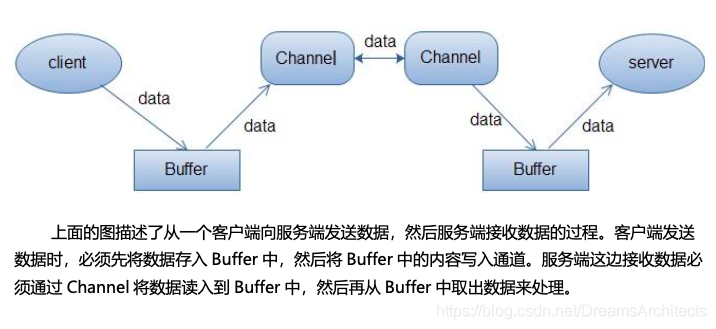NIO目录
一、NIO编程
NIO有两种叫法:有人称之为New I/O;更多的人喜欢称之为Non-block I/O:非阻塞I/O,后者更能体现NIO的特点。
与Socket和ServerSocket类相对应,NIO也提供了SocketChannel和ServerSocketChannel两种不同的套接字通道实现。这两种新增的通道都支持阻塞与非阻塞两种模式。一般来说:低负载、低并发的应用程序可以选择同步阻塞I/O以降低编程复杂度;对于高负载、高并发的应用程序,需要使用NIO的非阻塞模式进行开发。
二、NIO类库和相关概念
在Java1.4之前的早期版本,Java对I/O的支持并不完善,开发人员在开发高性能I/O程序的时候,会面临一些巨大的挑战和困难。主要问题如下:
- 没有数据缓冲区,I/O性能存在问题。
- 没有Channel通道的概念,只有输入和输出流。
- 同步阻塞式I/O通信(BIO),通常会导致通信线程被长时间阻塞。
- 支持的字符集有限,硬件可移植性不好。
NIO 主要有三大核心部分:Channel(通道),Buffer(缓冲区), Selector。传统 IO 基于字节流和字 符流进行操作,而 NIO 基于 Channel 和 Buffer(缓冲区)进行操作,数据总是从通道读取到缓冲区中,或者从缓冲区写入到通道中。
NIO 和传统 IO 之间第一个最大的区别是,IO 是面向流的,NIO 是面向缓冲区的。
缓冲区Buffer
Buffer是一个对象,它包含一些要写入或者要读出的数据,在NIO类库中加入Buffer对象,体现了新库与原来I/O的一个重要区别。在面向流的IO中,可以将数据直接写入或者将数据直接得到Stream对象中。
在NIO库中,所有数据都是用缓冲区处理的,在读取数据时,他是直接读到缓冲区的;在写入数据时,写入带缓冲区中,任何时候访问NIO中的数据都是通过缓冲区进行操作。
缓冲区实质上是一个数组。通常它是一个字节数组(ByteBuffer),也可以使用其他种类的数组,但是一个缓冲区不仅仅是一个数组,缓冲区提供了对数据的结构化访问以及维护读写位置(limit)等信息。
最常用的是ByteBuffer,一个ByteBuffer提供了一组功能用于操作byte数组,每一种Java基本类型都对应有一种缓冲区(除了Boolean)。
ByteBuffer、CharBuffer、ShortBuffer、IntBuffer、LongBuffer、FloatBuffer、DoubleBuffer。
通道Channel
Channel是一个通道。它就像一个自来水管一样,网络数据通过Channel都读取和写入。通道和流的不同之处在于通道是双向的,流只是在一个方向上移动(一个流必须是InputStream或者OutputStream的子类)。而通道可以用于读、写或者二者同时进行。Channel是双全工的。同时支持读写操作。
多路复用器Selector
多路复用器Selector是JavaNIO编程的基础。简单来讲:Selector会不断轮询注册在其上的Channel,如果某个Channel上面发生读或写事件,这个Channel就处于就绪状态,会被Selector轮询出来,然后通过SelectorKey可以获取就绪Channel的集合,进行后续的I/O操作。
一个多路复用器Selector可以同时轮询多个Channel,只需要一个线程负责Selector的轮询,就可以接入成百上千的客户端。
三、NIO服务端流程分析
- 打开
ServerSocketChannel,用于监听客户端的连接,它是所有客户端连接的父管道。 - 绑定监听端口,设置连接为非阻塞模式。
- 创建Reactor线程创建多路复用器
Selector并启动线程。 - 将
ServerSocketChannel注册到Reactor线程的多路复用器Selector上,监听ACCEPT事件。 - 多路复用器Selector在线程run方法的无限循环体内轮询准备就绪的Key。
- 多路复用器Selector监听到有新的客户端接入,处理新的请求,完成TCP三次握手,建立物理链路。
- 设置客户端链路为非阻塞模式。
- 将新接入的客户端连接注册到Reactor线程的多路复用器上,监听
读操作。 - 异步读取客户端请求消息到缓冲区。
- 对ByteBuffer进行编解码,如果有半包消息指针reset,继续读取后续的报文,将解码成功的消息封装成Task,投递到业务线程池中,进行业务逻辑编排。
- 将POJO对象encode成ByteBuffer,调用SocketChannel的异步write接口,将消息异步发送给客户端。
四、NIO客户端流程分析
- 打开
SocketChannel,绑定客户端本地地址。 - 设置SocketChannel为非阻塞模式。同时设置客户端连接的TCP参数
- 异步连接服务端
- 判断连接是否成功。如果连接成功,则直接注册读状态位到多路复用器Selector中,如果当前没有连接成功(异步连接,返回false,说明客户端已经发送sync包,服务端没有返回ack包,物理链路还没有建立)
- 向Reactor线程的多路复用器注册
OP_CONNECT状态位,监听服务端的TCP ACK应答。 - 创建Reactor线程,创建多路复用器
Selector并启动线程。 - 多路复用器在线程run方法的无限循环体内轮询准备就绪的key。
- 接收
connect事件进行处理。 - 判断连接结果,如果连接成功,注册读事件到多路复用器。
- 异步读客户端请求消息到缓冲区。
- 对ByteBuffer进行
编解码,如果有半包消息接收缓冲区Reset,继续读取后续的提交,将解码成功的消息封装成Task,投递到业务线程池中,进行业务逻辑编排。 - 将POJO对象encode成
ByteBuffer,调用SocketChannel的异步write接口将消息异步发送给客户端。

五、NIO编程的优点
NIO编程的难度确实比同步阻塞的BIO编程大很多。我们的NIO实例没有考虑“半包读”和“半包写”,如果加上这些,代码将会更加复杂,既然代码这么复杂,为什么它的应用却越来越广泛呢?使用NIO编程的优点总结如下:
客户端发起的连接时异步的,可以通过在多路复用器注册OP_CONNECT等待后续结果,不需要像之的客户端那样被同步阻塞。SocketChannel的读写操作都是异步的,如果没有可读写的数据它不会同步等待,直接返回,这样IO通信线程就可以处理其他的链路,不需要同步等待这个链路可用。线程模型的优化,由于JDK的Selector在Linux等主流操作系统上通过epoll实现,它没有连接句柄数的限制(只受限于操作系统的最大句柄数或者对单个进程的句柄限制),这意味着一个Selector线程可以同时处理成千上万个客户端连接,而且性能不会随着客户端的增加而线性下降,因此,它非常适合做高性能、高负载的网络服务器。
源码
TimeServer
创建一个多路复用类(MultiplexerTimeServer),是一个独立负责的线程,负责轮询多路复用器Selector,可以处理多个客户端的并发接入。
public class TimeServer {
public static void main(String[] args) {
int port = 8080;
MultiplexerTimeServer timeServer = new MultiplexerTimeServer(port);
new Thread(timeServer,"NIO-MultiplexerTimeServer-001").start();
}
}
MultiplexerTimeServer
package com.lsh.nio;
import java.io.IOException;
import java.net.InetSocketAddress;
import java.nio.ByteBuffer;
import java.nio.channels.SelectionKey;
import java.nio.channels.Selector;
import java.nio.channels.ServerSocketChannel;
import java.nio.channels.SocketChannel;
import java.util.Date;
import java.util.Iterator;
import java.util.Set;
/**
* @author :LiuShihao
* @date :Created in 2021/3/1 12:03 下午
* @desc :NIO时间服务器 MulitiplexerTimeServer 多路复用器
* 它是一个独立的线程,负责轮询多路复用器Selector,可以处理多个客户端的并发接入。
*/
public class MultiplexerTimeServer implements Runnable{
private Selector selector;
private ServerSocketChannel serverChannel;
private volatile boolean stop;
/**
* 初始化多路复用器 绑定监听端口
* 创建多路复用器Selector、ServerSocketChannel
* 对Channel和TCP参数进行配置
* @param port
*/
public MultiplexerTimeServer(int port) {
try {
//创建Reactor线程,创建多路复用器
selector = Selector.open();
//打开ServerSocketChannel,用于监听客户端的连接,它是所有客户端连接的父管道
serverChannel = ServerSocketChannel.open();
//将Channel设置为异步非阻塞模式,他的backlog设置为1024
serverChannel.configureBlocking(false);
//绑定监听接口
serverChannel.socket().bind(new InetSocketAddress(port),1024);
//将ServerSockrtChannel注册到Reactor线程的多路复用器Selector上,监听ACCEPT事件
serverChannel.register(selector, SelectionKey.OP_ACCEPT);
System.out.println("The time server is start in port :"+port);
} catch (IOException e) {
e.printStackTrace();
//如果资源初始化失败,如端口被占用,则退出
System.exit(1);
}
}
public void stop(){
this.stop = true;
}
@Override
public void run() {
/**
* 多路复用器在run方法的无限循环体中内轮询准备就绪的key
* 在while循环体中,循环遍历selector,休眠时间为1秒,无论是否有读写时间发生,selector每隔1s都被唤醒1次
* 当有处于就绪状态的Channel时,selector将返回该Channel的SelectionKey集合,通过对就绪状态的Channel集合进行迭代,可以进行网络的异步读写操作。
*/
while(!stop){
try {
selector.select(1000);
Set<SelectionKey> selectionKeys = selector.selectedKeys();
Iterator<SelectionKey> it = selectionKeys.iterator();
SelectionKey key = null;
while(it.hasNext()){
key = it.next();
it.remove();
try{
handlerInput(key);
}catch (Exception e){
if (key != null){
key.cancel();
if (key.channel() != null){
key.channel().close();
}
}
}
}
} catch (Throwable t) {
t.printStackTrace();
}
}
//多路复用器关闭 后,所有注册在上面的Channel和Pipe等资源都会被自动用去注册并关闭,所以不需要重复释放资源
if (selector != null){
try {
selector.close();
} catch (IOException e) {
e.printStackTrace();
}
}
}
/**
* 根据SelectorKey的操作位进行判断即可获知网络时间的类型,
* @param key
* @throws IOException
*/
private void handlerInput(SelectionKey key) throws IOException{
if (key.isValid()){
//处理新接入的消息请求
if (key.isAcceptable()){
//Accept the new connection
ServerSocketChannel ssc = (ServerSocketChannel) key.channel();
//通过ServerSocketChannel的accept接收客户端的链接请求并创建SocketChannel实例,相当于完成了TCP的三次握手,TCP物理链路正式建立。
SocketChannel sc = ssc.accept();
//需要将新创建的SocketChannel设置为异步非阻塞,同时也可以对其TCP参数进行设置,例如TCP接收和发送缓冲区的大小等,但作为入门的例子,没有进行额外的参数设置。
sc.configureBlocking(false);
// Add the new connection to the selector
//将新接入的客户端连接注册到Reactor线程的多路复用器上,监听读操作,读取客户端发送的网络消息。
sc.register(selector,SelectionKey.OP_READ);
}
if (key.isReadable()){
//Read the data
SocketChannel sc = (SocketChannel) key.channel();
ByteBuffer readBuffer = ByteBuffer.allocate(1024);
// 异步读取客户端消息到缓冲区
int readBytes = sc.read(readBuffer);
if (readBytes > 0){
readBuffer.flip();
byte[] bytes = new byte[readBuffer.remaining()];
readBuffer.get(bytes);
String body = new String(bytes, "UTF-8");
System.out.println("The time server receive order :"+body);
String currentTime = "QUERY TIME ORDER".equalsIgnoreCase(body) ? new Date(System.currentTimeMillis()).toString() : "BAD ORDER";
doWrite(sc,currentTime);
} else if (readBytes < 0 ){
//对端链路关闭
key.cancel();
sc.close();
}else {
;//读到0字节,忽略
}
}
}
}
private void doWrite(SocketChannel channel, String response) throws IOException{
if (response != null && response.trim().length() > 0 ){
//将消息encode成ByteBuffer,调用SocketChannel的异步write接口,将消息异步发送给客户端。
byte[] bytes = response.getBytes();
ByteBuffer writeBuffer = ByteBuffer.allocate(bytes.length);
writeBuffer.put(bytes);
writeBuffer.flip();
channel.write(writeBuffer);
}
}
}
TimeClient
public class TimeClient {
public static void main(String[] args) {
int port = 8080;
//通过创建TimeClient线程来处理异步连接和读写操作
new Thread(new TimeClientHandle("127.0.0.1",port),"TimeClinet-001").start();
}
}
TimeClientHandle
package com.lsh.nio;
import java.io.IOException;
import java.net.InetSocketAddress;
import java.nio.ByteBuffer;
import java.nio.channels.SelectionKey;
import java.nio.channels.Selector;
import java.nio.channels.SocketChannel;
import java.util.Iterator;
import java.util.Set;
/**
* @author :LiuShihao
* @date :Created in 2021/3/1 2:18 下午
* @desc :NIO时间服务器客户端 Handle
*/
public class TimeClientHandle implements Runnable {
private String host;
private int port;
private Selector selector;
private SocketChannel socketChannel;
private volatile boolean stop;
public TimeClientHandle(String host, int port) {
this.host = host == null ? "127.0.0.1" : host;
this.port = port;
try {
selector = Selector.open();
socketChannel = SocketChannel.open();
socketChannel.configureBlocking(false);
} catch (IOException e) {
e.printStackTrace();
System.exit(1);
}
}
@Override
public void run() {
try{
doConnect();
}catch (Exception e){
e.printStackTrace();
System.exit(1);
}
while(!stop){
try{
selector.select(1000);
Set<SelectionKey> selectionKeys = selector.selectedKeys();
Iterator<SelectionKey> it = selectionKeys.iterator();
SelectionKey key = null;
while(it.hasNext()){
key = it.next();
it.remove();
try{
handleInput(key);
}catch (Exception e){
if (key != null){
key.cancel();
if (key.channel() != null){
key.channel().close();
}
}
}
}
}catch (Exception e){
e.printStackTrace();
System.exit(1);
}
}
// 多路复用器关闭后,所有注册在上面的Channel和Pige等资源都会被自动去注册并关闭,所以不需要重读释放资源。
if (selector != null){
try{
selector.close();
}catch (Exception e){
e.printStackTrace();
}
}
}
private void handleInput(SelectionKey key) throws IOException{
if (key.isValid()){
//判断是否连接成功
SocketChannel sc = (SocketChannel) key.channel();
if (key.isConnectable()){
if (sc.finishConnect()){
sc.register(selector,SelectionKey.OP_READ);
doWrite(sc);
}else {
//连接失败,进程退出
System.exit(1);
}
}
if (key.isReadable()){
ByteBuffer readBuffer = ByteBuffer.allocate(1024);
int readBytes = sc.read(readBuffer);
if (readBytes > 0 ){
readBuffer.flip();
byte[] bytes = new byte[readBuffer.remaining()];
readBuffer.get(bytes);
String body = new String(bytes,"UTF-8");
System.out.println("Now is :"+body);
this.stop = true;
} else if (readBytes < 0 ){
key.cancel();
sc.close();
}else {
;//读到0字节,忽略
}
}
}
}
private void doConnect() throws IOException{
//如果直接连接成功,则注册到多路复用器上,发送请求消息,读应答
if (socketChannel.connect(new InetSocketAddress(host,port))){
socketChannel.register(selector,SelectionKey.OP_READ);
doWrite(socketChannel);
}else {
socketChannel.register(selector,SelectionKey.OP_CONNECT);
}
}
private void doWrite(SocketChannel sc) throws IOException{
byte[] req = "QUERY TIME ORDER".getBytes();
ByteBuffer writeBuffer = ByteBuffer.allocate(req.length);
writeBuffer.put(req);
writeBuffer.flip();
sc.write(writeBuffer);
if (!writeBuffer.hasRemaining()){
System.out.println("Send order 2 server succeed.");
}
}
}